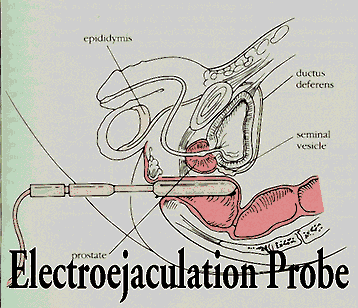Treating
Male Infertility
A wide variety of treatment options are available for the many causes
of male infertility. Simple lifestyle changes, like abstaining from
alcohol, tobacco, and illicit drugs can improve male fertility. A
healthy diet, sufficient exercise (but not excessive exercise), and proper
amounts of vitamin B12, vitamin C, and zinc also improve fertility.
Treating Hormonal Problems:
Several drugs are available to treat pituitary and hormonal imbalances:
· If LH and FSH levels are low and the hypothalamus and pituitary
gland are functional, the drug
clomiphene citrate (Serophene, Clomid) is able to stimulate
the hypothalamus to release GnRH at
regular intervals and restore fertility.
· If the pituitary is malfunctioning and not manufacturing the
necessary sex hormones, hormone
replacement therapy can restore fertility. Injections
of hCG (human chorionic gonadotropin)
increases the LH supply and can stimulate the testes to produce
testosterone and sperm.
· If unresponsive to hCG, the drug Pergonal (a combination of
LH and FSH) can stimulate sperm
production.
· The drug Parlodel (bromocriptine) can correct hyperprolactinemia.
· Cortisone replacement therapy can lower abnormally high androgen
levels and allow the pituitary
to function normally to restore fertility.
· Hormone replacement therapy usually works in about 4 months.
Treating Physical Problems:
Varicocele: Are most successfully repaired by microsurgery.
Surgical repair improves the semen in 70 percent of men and results in
pregnancy in 60 percent of couples. Surgery involves the interruption
of the damaged testicular veins. Men who are infertile due to varicoceles
can also achieve fertilization via intrauterine insemination, in-vitro
fertilization (IVF--more on this technique later), and treatment with the
drug clomid.
Blocked Ducts: As mentioned earlier, the path through which
sperm pass from the testicle to outside of the penis can become interrupted
or blocked by several conditions. In the case of voluntary or accidental
vasectomy, a vasectomy reversal can be performed which reconnects the testicle
to the vas deferens. Tubal scarring due to an STD or tuberculosis
can also be fixed by microsurgical techniques. In the cases of a
congenital absence of the vas deferens, failed vasectomy reversals, and
other irreparable obstructions, menís sperm can be retrieved via three
methods. Once sperm is retrieved, the sperm are used to fertilize
the egg of a woman who has undergone a typical IVF cycle.
Sperm retrieval methods are:
· Micro Epididymal Sperm Aspiration (MESA)--involves a delicate
surgical technique that utilizes
a microscope to get a sperm sample from a location proximal
to the tubal obstruction.
· Percutaneous Epididymal Sperm Aspiration (PESA)--a small needle
is used to aspirate sperm
from a location proximal to the tubal obstruction.
· Testicular Sperm Biopsy (TESE)--a small biopsy of testicular
tissue is taken and a sperm sample is
removed from the biopsy.
Ejaculatory Disfunction: Men who suffer from conditions
that render them unable to ejaculate (neurologic disease, traumatic injury,
or surgical complication), can achieve ejaculation by two currently used
techniques.
· Vibratory stimulation employs a custom designed mechanical
vibrator to stimulate the underside of
the glans penis to induce a reflex ejaculation. This technique
only works in patients with an intact
ejaculatory reflex arc.
· For men for which vibratory stimulation is ineffective, a
procedure called electroejaculation can be
used to induce ejaculation. A specially designed electric probe
is inserted into the rectum next
 to the prostate.
A current generated by the
to the prostate.
A current generated by the
device stimulates the nerves of the pelvic muscles to induce
a contraction and cause an ejaculation.
Retrograde ejaculation can be treated with decongestant medication
(which causes the bladder
sphincter to close and allows semen to pass to the penis) or
by tubal constructive surgery.
Treating Psychological/Physical
Problems:
Erectile Dysfunction: Treatment for ED can be divided into
four broad categories, pharmacological, mechanical, surgical, and psychological.
· Pharmacological treatment: Involves the delivery
of medications that restore erections. Several
drugs are currently used to treat ED. Sildenafil (Viagra)
is taken orally to increase penile blood
flow; it is highly effective. Caverject is a drug injected
directly into the penis to cause an
erection; it is highly effective. Papaverine is another
injectible drug that is highly effective.
Yohimbine is a dietary supplement taken orally that is moderately
effective. Testosterone
replacement therapy is highly effective for men with low testosterone
levels.
· Mechanical Treatment: Involves the use of a vacuum
erection device with a constriction ring.
The vacuum device vacuums the penis into an erection and the
constriction ring keeps blood from
exiting the spongy bodies of the penis to maintain the erection.
This treatment is effective but
obviously cumbersome.
· Surgical Treatment: Involves the use of implants
or the correction of vascular damage/blockage
to restore erectile capacity. Penile implants work excellently:
there are 2 types. A semi-rigid
implant keeps the penis in a perpetual semi-rigid state.
Inflatable implants allow the man to
ďpumpĒ his penis into an erection. Arterial and
venous reconstructive surgery works moderately
well and may restore a manís ability to achieve an erection.
· Psychological therapy is useful in the cases of ED which are
a direct result of psychological
causes. These patients may also benefit from pharmacological
or combination therapy.
Treating Premature Ejaculation:
Premature ejaculation can be treated by the squeeze technique in which
a man is stimulated until close to orgasm and then his frenulum is squeezed
by his partner. This procedure is repeated until the penis becomes
desensitized and longer intercourse becomes feasible. Premature ejaculation
can also be treated by collecting the ejaculate and using artificial insemination
to fertilize the egg.
Treating Ejaculatory Incompetence:
Ejaculatory incompetence can be treated by behavioral therapy in some
cases. With behavioral therapy, ejaculation may be stimulated by
combining masturbation and manual stimulation with eventual penile insertion
into the vagina. If this therapy does not work, artificial insemination
with an ejaculate obtained through masturbation can be used to overcome
infertility.
[Home]
[Previous][Next]
 to the prostate.
A current generated by the
to the prostate.
A current generated by the